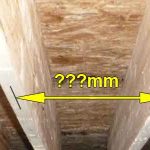I joists can be a great alternative to solid timber joists and they come with several advantages. These include:
- Superior tensile strength
- Available in increased depth allowing them to span further
- Completely straight
- Lightweight and easy to work with
- No need for noggins
- Don’t suffer from shrinking and movement
Generally, a length of I Joists will be more expensive than a similar sized length of timber joist. This can range anywhere between 30-70% more per meter. The reason for this range, is the competitive nature of the industry, So you may need to shop around, to find the best deals.

How I Joists can actually be cheaper than timber joists
If you are fitting joists, there are several things you may need to consider, in order to achieve the best possible finish. Things to take into consideration are the dimensions of the area, the span that joists will need to travel. As well as labour and access costs.
In many cases, I Joists can actually save you money, despite a higher cost per meter. For example, due to their superior strength, they can span larger distances without additional support, they can also be fixed at wider centres and don’t require noggins.
Let’s look at a simple example where joists are being installed in an area of 10×4 meters.
If timber joists are fitted at intervals of 400mm, this would mean you require 10 lengths of timber joist.
Generally, timber joists suitable for this job would be available in 4.2m or 4.8m lengths. If we intend to add noggins down the middle, to add extra stability, then 4.8m would be the most cost effective. A 4.8m length will produce usable waste from the joists that can create noggins.
This would mean we are using 48m (10 x 4.8m) of timber joist to complete this job.
Now let’s look at the same job using I Joists. in this example, due to the extra strength, the I joists will have 600mm centres instead of 400mm. This instantly means we can drop the number of lengths to 7.
We can also buy I Joists in the exact length at 4m. This means there will be zero waste. There is also no need for noggins.
This would mean we are using just 28m (7 x 4m) of I joist for the exact same job.
Therefor, the meters of I joist used would be roughly 40% lower than using timber joists. Obviously, if you are getting a good price on the I joists, this type of saving alone could make I joist cheaper than timber.
I joists can result in lower labour costs
One major advantage of I joists, is they are lightweight and easy to work with. This alone can save significant amounts of time during installation.
I joists are a manufactured product and they use around 50% less material than a standard joist. The I joist is made up of two main components:
- The Web – This is the middle of the joist, and it is generally made of an engineered wood, such as OSB (Oriented strand board).
- The Flange – These form the thicker top and bottom of the joist. It is usually made from solid timber or a Laminated veneer lumber.
Due to less material being used to construct the joists, they are considerably lighter. This can mean the joiners installing them can complete the job much quicker and more easily.
In most cases, there are also less joists due to the wider centres that can be used with I joists. This again will reduce the labour time considerably.
Essentially, they are far less labour intensive. If you have 2 joiners fitting 30-40% less joists, that weigh 50% less than standard joists, you can easily see how this would save time.
Conclusion I joists vs timber joists – Which is cheaper?
As you can see, on a purely like for like basis, I joists are definitely more expensive than a standard timber joist. However, they do come with many advantages that can actually lower the cost of doing the work.
Which type ends up being cheaper, will depend on a variety of factors. These include:
- The price you can get each joist for. To do this you will need to shop around and get quotes to find the best like for like prices.
- The dimensions and scope of the job. This is simply a case of doing the maths and figuring out what you need to complete the job. You will need to factor in waste and how you can use the materials most efficiently.
- Labour costs. Will there be less work needed and hence less labour expense.
So, as you can see there is no one definitive answer here. It will depend. Its simply a case of sitting down with a calculator and working it out. You may find that all the factors combined make the higher price per unit well worth it.




